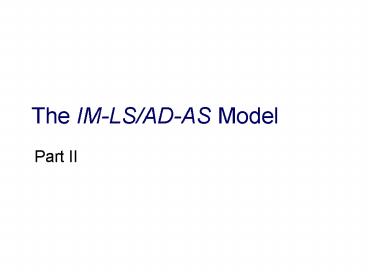The IMLSADAS Model PowerPoint PPT Presentation
1 / 18
Title: The IMLSADAS Model
1
The IM-LS/AD-AS Model
Part II
2
Overview
- The Classical-Keynesian Debate
- AD-AS Model
- Equilibrium in the AD-AS Model
3
The Debate Between the Classicals and Keynesians
- Two questions central to the debate
- How rapidly does the economy reach general
equilibrium? - What are the effects of monetary policy on the
economy?
4
Price Adjustment and the Self-Correcting Economy
- After an initial LM curve shift, the price level
adjusts and shifts the LM curve back to the
general equilibrium. - The classical assumption is that prices are
flexible and the adjustment process is rapid.
5
Price Adjustment (continued)
- According to the Keynesian view, sluggish
adjustment of prices might prevent general
equilibrium from being attained for a much longer
period of time. - The economy is not in general equilibrium and the
labour market is not in equilibrium.
6
Stabilization Policy
- Unexpected shifts in the IS, LM and the FE curves
are the sources of business cycles. - Stabilization policy is the use of fiscal and
monetary policy to shift the position of the IS
and LM curves so as to offset the effects of such
shocks.
7
Monetary Neutrality
- There is monetary neutrality if a change in the
nominal money supply changes the price level
proportionally but has no effect on real
variables. - Keynesians believe in monetary neutrality in the
long run but not in the short run.
8
The AD-AS Model
- The AD-AS and the IS-LM models are equivalent.
- The IS-LM model relates the real interest rate to
output. - The AD-AS model relates the price level to
output.
9
The Aggregate Demand Curve
- The aggregate demand curve shows the relation
between the aggregate quantity of goods demanded
(CdIdG) and the price level, P. - The AD curve slopes downward.
10
(No Transcript)
11
Factors That Shift the AD Curve
- For a constant price level
- any factor that changes the aggregate demand for
output will cause the AD curve to shift - any factor that causes the intersection of the IS
and the LM curves to shift will cause the AD to
shift.
12
(No Transcript)
13
The Aggregate Supply Curve
- The aggregate supply curve shows the relation
between the price level and the aggregate amount
of output that firms supply. - The prices remain fixed in the short run and the
short-run aggregate supply curve (SRAS) is a
horizontal line.
14
- The prices adjust to clear all the markets in the
long run, employment equals and the output
supplied is the full-employment output . - The long-run aggregate supply curve (LRAS) is a
vertical line.
15
Factors That Shift the AS Curve
- Any factor that changes the full-employment level
of output, , shifts the LRAS. - The SRAS curve shifts whenever firms change their
prices in the short-run (e.g. due to costs
changes).
16
Equilibrium in the AD-AS Model
- Long-run equilibrium is the same as general
equilibrium because in long-run equilibrium, all
markets clear. - In general equilibrium, or long-run equilibrium,
AD, SRAS, and LRAS curves intersect at a common
point.
17
Monetary Neutrality in the AD-AS Model
- An increase in M shifts the AD curve up and to
the right. - In the short run the price level remains fixed
and SRAS does not change.
18
- In the long run the price level rises, the SRAS
shifts up to the point where the AD and the LRAS
curves intersect. - We conclude that money is neutral in the long-run.

